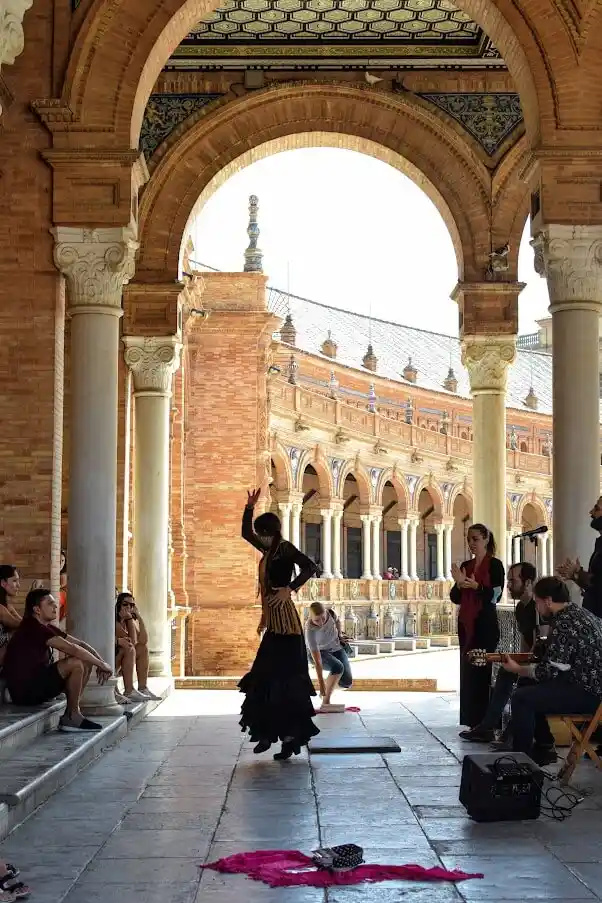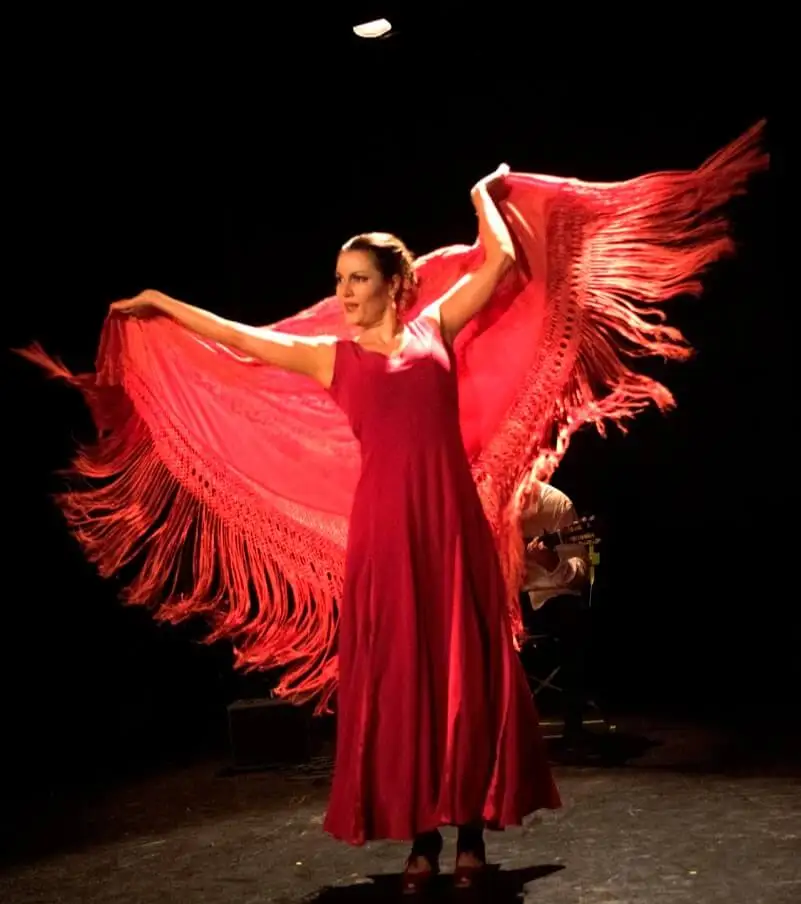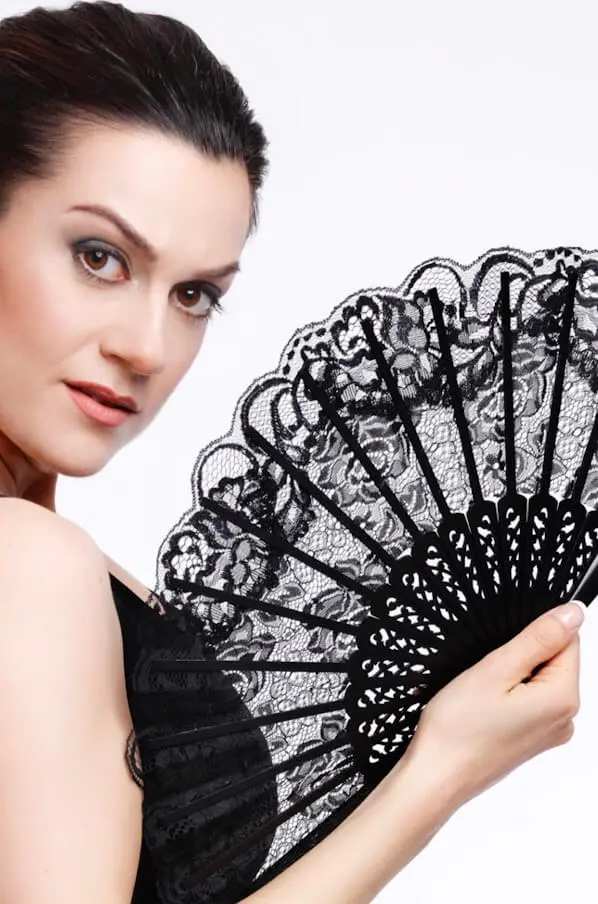The majority of people visiting southern Spain wants to see the Flamenco performance. But, what is Flamenco actually? And what are its origins? In this article, you’ll learn more about it through a brief introduction to that art form and an interview with the Flamenco dancer, Aylin Bayaz.
What is Flamenco?
Flamenco is a unique art form typical for the region of Andalusia in Spain. It consists of dance, singing and music. However, its origins aren’t completely clear. What’s certain is that it is associated with the migrations of Roma people from Rajasthan in India between the 9th and 14th centuries.
Over time, they mixed their influences with the cultural heritage of Moors and Sephardic Jews. That fantastic cultural mix that could be felt all over Andalusia could definitely be seen in Flamenco, as well.
Flamenco music was first mentioned in ‘Las Cartas Marruecas’ book written by José Cadalso in 1774. It probably appeared as an art form somewhere at that time, too. And it got to its peak during the 19th and 20th centuries.
⤷ Read more: How people started to travel
Although the first association to Flamenco is dancing, it’s much more than just that. It as an art form consists of music, song and dance.
Its music is performed by guitar, in a technique called tocaores. In it, the guitarist holds the instrument in an almost horizontal position. The Flamenco singer is called cantaor and performs Andalusian songs. The third element is a dance, which is very emotional, proud and expressive. Over time, many different styles of its dance have developed.
⤷ Read more: Love in art history
Interview with the Flamenco dancer Aylin Bayaz
To understand it even better, I asked a lovely and talented Flamenco dancer Aylin Bayaz a few questions about it.
1/ Can you tell me a bit about yourself?
I am a contemporary Flamenco dancer based in Sitges, near Barcelona. Before moving there, I lived in Madrid, where I trained in Flamenco at the Amor de Dios Studios for years. There, I danced in tablaos flamencos to become a professional dancer.
2/ How did you decide to become a Flamenco dancer?
I was studying at University when a friend took me to a violin concert with Flamenco influences. I was totally captured by the energy and movement that the music transmitted. Later, I moved to Seville for two and a half months and took a visceral decision to stay in Spain and study Flamenco. I was very eager about learning and discovering that art form. I never really thought I would become a professional dancer until years later when I moved to Madrid to train professionally and later to Barcelona to continue my MA in dance.
3/ What does Flamenco dance represent to you?
In my case, it means life, dedication and honesty. It’s how this kind of profession works. It also means freedom – it’s a dance form that doesn’t require perfection. Although, striving for the best quality of performance is always there.
However, a very difficult aspect of it is to get your work seen. Finding performing opportunities, especially if you are your own representative, means you need to send a lot of emails, talk with theatres, organise and schedule rehearsals.
4/ What are the most common themes of Flamenco songs?
Life, pain, death, love, humour. The verses of the songs are short poems, primarily transmitted from past generations by singing.
5/ How does Flamenco represent Spanish culture in your opinion?
We live in a new time with a new rhythm to life. This is obviously reflected in all art forms that allow space for spontaneity and development. Flamenco is attractive in a way it has its own characteristic system of functioning, a kind of phrasing that allows the performer to add their own element and style to it.
6/ How do you create your choreography? Is it all planned, or do you also improvise during the performances?
What looks simple usually has a lot of work behind it. Because it’s such a great musical style, no amount of work is ever enough, really.
In my case, the dance numbers have a pre-set structure. However, the result comes out a little different in each performance, depending on the theatre space, atmosphere, and music. Leaving a little spontaneity makes the performance lively. But basically, the more prepared the show is, the better the outcome.
7/ What are some of the best places in Spain to see the Flamenco performances?
If you prefer to see it close to the performers in an informal setting, tablaos flamencos are the best option. In case you’d like to go and see it in a theatre, there are several festivals and theatres in Spain that offers Flamenco in their program.
⤷ TIP: You can check out the Flamenco theatre performances agenda on a link here.
8/ How did this art form changed from traditional to contemporary Flamenco?
There is a sort of mystery around the its origins and development. What’s known for sure is that it’s a relatively young art form with two centuries of history. It has its roots in Andalusia, where it developed as a mixture of Roma, Arab, Christian and Jewish cultures. Later it was modernised, exported to the world and opened to other influences by Paco de Lucía and Camarón. In both music and dance, you can hear quite a lot of influences, anything from Jazz, Latin music, contemporary dance etc. The art form has been kept alive by balancing past references with each individual’s adaptations.
Flamenco mostly isn’t based on any notation or fixed repertoire, which gives it an honest and spontaneous, quite a direct character with a lot of work for the performer when it comes to creating or organising the repertoire. I feel Flamenco dance is a mixture of the Andalusian accent, the rigour of baile flamenco and a personal element.
9/ What are some of your favourite Flamenco songs?
Paco de Lucía and Camarón are the most famous references and influencers of today’s Flamenco. So, what I mostly tend to listen goes back to their genius or is influenced or inspired by them.
⤷ Read more: The most interesting European myths and legends
10/ Where can Culture Tourist readers see you perform?
At the moment, we are performing our Duo show ‘Flamencodanza’, premiered at the Avignon festival in 2021, in the Cultural centres of Madrid and Barcelona. We also have some upcoming performances in London in March, and are preparing for a possible tour in the USA.
⤷ You can follow Aylin’s work and check her shows agenda on her website (here is the link).
Learning about local cultures through their art is probably the best way to understand them. Flamenco dance is an indispensable part of Andalusian and Spanish culture. I hope this article helped you understand better what it is. And that it inspired you to see some Flamenco performances during your next trip to Spain.
Many thanks to Aylin Bayaz for this interview.





